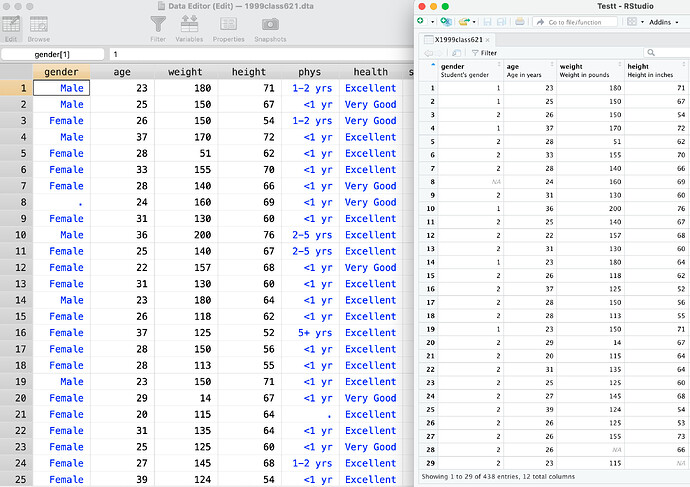dput(head(initial_df,5))
structure(list(gender = structure(c(1, 1, 2, 1, 2), label = "Student's gender", format.stata = "%8.0g"),
age = structure(c(23, 25, 26, 37, 28), label = "Age in years", format.stata = "%9.0g"),
weight = structure(c(180, 150, 150, 170, 51), label = "Weight in pounds", format.stata = "%9.0g"),
height = structure(c(71, 67, 54, 72, 62), label = "Height in inches", format.stata = "%9.0g"),
phys = structure(c(2, 1, 2, 1, 1), label = "Length of time since check-up", format.stata = "%8.0g"),
health = structure(c(1, 2, 2, 1, 1), label = "General health status", format.stata = "%9.0g"),
smoke100 = structure(c(2, 2, 2, 2, 2), label = "Smoked 100 cigarettes during lifetime", format.stata = "%8.0g"),
cursmoke = structure(c(3, 3, 3, 3, 3), label = "Current cigarette smoker", format.stata = "%10.0g"),
wtchange = structure(c(1, 3, 2, 1, 1), label = "Satisfaction with weight", format.stata = "%15.0g"),
exercise = structure(c(1, 1, 1, 1, 1), label = "Daily level of recreational exercise", format.stata = "%8.0g"),
degree = structure(c(4, 4, 4, 1, 4), label = "Highest degree attained", format.stata = "%14.0g"),
program = structure(c(3, 2, 3, 3, 2), label = "Current degree program", format.stata = "%12.0g")), row.names = c(NA,
-5L), class = c("tbl_df", "tbl", "data.frame"))
dput(head(fixed_df,5))
structure(list(gender = structure(c(1, 1, 2, 1, 2), label = "Student's gender", format.stata = "%8.0g"),
age = structure(c(23, 25, 26, 37, 28), label = "Age in years", format.stata = "%9.0g"),
weight = structure(c(180, 150, 150, 170, 51), label = "Weight in pounds", format.stata = "%9.0g"),
height = structure(c(71, 67, 54, 72, 62), label = "Height in inches", format.stata = "%9.0g"),
phys = structure(c(2, 1, 2, 1, 1), label = "Length of time since check-up", format.stata = "%8.0g"),
health = structure(c(1, 2, 2, 1, 1), label = "General health status", format.stata = "%9.0g"),
smoke100 = structure(c(2, 2, 2, 2, 2), label = "Smoked 100 cigarettes during lifetime", format.stata = "%8.0g"),
cursmoke = structure(c(3, 3, 3, 3, 3), label = "Current cigarette smoker", format.stata = "%10.0g"),
wtchange = structure(c(1, 3, 2, 1, 1), label = "Satisfaction with weight", format.stata = "%15.0g"),
exercise = structure(c(1, 1, 1, 1, 1), label = "Daily level of recreational exercise", format.stata = "%8.0g"),
degree = structure(c(4, 4, 4, 1, 4), label = "Highest degree attained", format.stata = "%14.0g"),
program = structure(c(3, 2, 3, 3, 2), label = "Current degree program", format.stata = "%12.0g")), row.names = c(NA,
-5L), class = c("tbl_df", "tbl", "data.frame")

